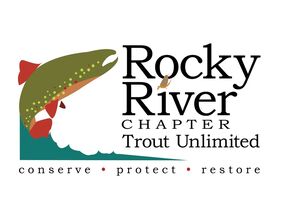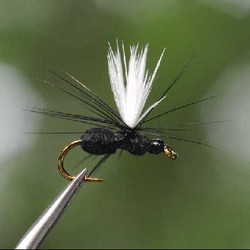Fly of the month 06.11 Parachute Ant
This “fly of the month” represents the latest in the Tim Wilhelm/Tom Adams series.
When I joined the chapter and started fly fishing, there were two individuals that took me under their wing and helped me learn, Denny Burries and Joe Summer. Both were excellent fly tiers and whenever the opportunity arose that I could “borrow” from one of them, I didn’t hesitate.
Such an occasion presented itself during a trip the three of us took to fish the fabled waters of Pennsylvania. We were on Big Springs and in the area where we were fishing, the far bank was reinforced with logs. Above the logs was a weedy area that sloped back in to a field. Joe was catching fish left and right and I wasn’t so I asked him what he had tied on. Joe told me a Cinnamon Ant. Joe would bounce his ant off the logs and into the water where the current took his offering down the length of the logs. He hadn’t used any floatant on the ant and sometimes it would slip below the surface where it was just as effective as when it remained on top.
I didn’t have an ant in my fly box so I immediately recognized this as an opportunity. “Joe, you wouldn’t have extra ant would ya?” “Sure!” he said with a sly grin as he produced a fly box I hadn’t seen before. Inside were some of the prettiest flies I had seen and there in the middle was the perfect Cinnamon Ant. I hastily took the fly before Joe had a chance to return the box to his vest and scurried downstream ten yards to tie on my prize.
After about 20 minutes Joe called down to me “Why aren’t you fishing? You are missing the best time.”
“Having a little trouble tying on this fly” I replied.
“Can’t seem to get the tippet through the eye.” Ten minutes later, I still hadn’t tied the fly on when I looked over at Joe and Denny and they were on the bank laughing hysterically. In an instant I knew I had been had. Besides being superb anglers, Joe and Denny were also known as accomplished pranksters. Seems the two of them had hatched a plan to deal with my habit of mooching flies and Joe had prepared a special batch of flies intended solely for my use. Just the proper amount of head cement had been strategically placed by Joe in the eye of each of those flies. I got even, but that is a story for another day.
Fly of the Month 06.11 Parachute Ant
Hook: Dry Fly, standard length, Tiemco 100 or equivalent, Size: 14, 16
Thread: 8/0 Uni Black
Body: Black Superfine or equivalent dubbing
Wing: T flat Turkey, white or bright color
Hackle: Black Rooster
Directions:
1) Begin tread wrap three eyelengths back from eye and wrap to the bend behind the point of the hook but before the curve of the bend
2) Dub the thread, somewhat heavily with black dubbing and begin wrapping the abdomen using tight turns to about one half the length of the hook. Repeat the dubbing and build a “fat”middle of the abdomen and take the thread to the middle of the hook at the forward edge of the dub and let the bobbin hang.
3) Select a white turkey flat and snip the center and most square section for the wing post. The length should be about the same as the hook shank. Tie in forward of the dubbed abdomen by laying the turkey on top of the hook with the tips toward the eye. Make several secure wraps and bring the thread forward of the tips and by pulling back toward the bend, the tips will stand up. Make several wraps in front of the post. Trim the excess length. Holding the turkey by the tip, make several close turns of thread up and down to stiffen the post and tighten the turkey.
4) Select a black hackle, strip the end about one eighth of an inch and tie in at the post. The hackle will tie in behind the post and bring the thread immediately forward of the post and let the bobbin hang.
5) Repeat the dubbing as above but make the thorax about one third to one half smaller than the abdomen. When you are satisfied with the thorax bring the thread to behind the thorax but in front of the post and let the bobbin hang
6) Grasp the hackle by the tip and wrap the bare stem up the post and then begin wrapping the hackle in tight, descending wraps down. Two or three turns should suffice (more turns for rougher waters) and secure with one or two wraps of thread. The thread should be “worked” into the hackle to minimize bunching of unwanted barbs. Grasp the hackle forward of the post with your left hand and pull back to finish securing the hackle. Using a small (tiny) amount of dub thread advance the thread to the eye.
7. Make a small head with thread wrap, cement to finish.
There are a good many ant fly patterns that include Cinnamon Parachute Ant, Red Parachute Ant, Brown Parachute Ant, Brown Ant wet, Cinnamon Ant wet, Red Ant wet and Black Ant wet.
- Tom Adams, Tim Wilhelm
This “fly of the month” represents the latest in the Tim Wilhelm/Tom Adams series.
When I joined the chapter and started fly fishing, there were two individuals that took me under their wing and helped me learn, Denny Burries and Joe Summer. Both were excellent fly tiers and whenever the opportunity arose that I could “borrow” from one of them, I didn’t hesitate.
Such an occasion presented itself during a trip the three of us took to fish the fabled waters of Pennsylvania. We were on Big Springs and in the area where we were fishing, the far bank was reinforced with logs. Above the logs was a weedy area that sloped back in to a field. Joe was catching fish left and right and I wasn’t so I asked him what he had tied on. Joe told me a Cinnamon Ant. Joe would bounce his ant off the logs and into the water where the current took his offering down the length of the logs. He hadn’t used any floatant on the ant and sometimes it would slip below the surface where it was just as effective as when it remained on top.
I didn’t have an ant in my fly box so I immediately recognized this as an opportunity. “Joe, you wouldn’t have extra ant would ya?” “Sure!” he said with a sly grin as he produced a fly box I hadn’t seen before. Inside were some of the prettiest flies I had seen and there in the middle was the perfect Cinnamon Ant. I hastily took the fly before Joe had a chance to return the box to his vest and scurried downstream ten yards to tie on my prize.
After about 20 minutes Joe called down to me “Why aren’t you fishing? You are missing the best time.”
“Having a little trouble tying on this fly” I replied.
“Can’t seem to get the tippet through the eye.” Ten minutes later, I still hadn’t tied the fly on when I looked over at Joe and Denny and they were on the bank laughing hysterically. In an instant I knew I had been had. Besides being superb anglers, Joe and Denny were also known as accomplished pranksters. Seems the two of them had hatched a plan to deal with my habit of mooching flies and Joe had prepared a special batch of flies intended solely for my use. Just the proper amount of head cement had been strategically placed by Joe in the eye of each of those flies. I got even, but that is a story for another day.
Fly of the Month 06.11 Parachute Ant
Hook: Dry Fly, standard length, Tiemco 100 or equivalent, Size: 14, 16
Thread: 8/0 Uni Black
Body: Black Superfine or equivalent dubbing
Wing: T flat Turkey, white or bright color
Hackle: Black Rooster
Directions:
1) Begin tread wrap three eyelengths back from eye and wrap to the bend behind the point of the hook but before the curve of the bend
2) Dub the thread, somewhat heavily with black dubbing and begin wrapping the abdomen using tight turns to about one half the length of the hook. Repeat the dubbing and build a “fat”middle of the abdomen and take the thread to the middle of the hook at the forward edge of the dub and let the bobbin hang.
3) Select a white turkey flat and snip the center and most square section for the wing post. The length should be about the same as the hook shank. Tie in forward of the dubbed abdomen by laying the turkey on top of the hook with the tips toward the eye. Make several secure wraps and bring the thread forward of the tips and by pulling back toward the bend, the tips will stand up. Make several wraps in front of the post. Trim the excess length. Holding the turkey by the tip, make several close turns of thread up and down to stiffen the post and tighten the turkey.
4) Select a black hackle, strip the end about one eighth of an inch and tie in at the post. The hackle will tie in behind the post and bring the thread immediately forward of the post and let the bobbin hang.
5) Repeat the dubbing as above but make the thorax about one third to one half smaller than the abdomen. When you are satisfied with the thorax bring the thread to behind the thorax but in front of the post and let the bobbin hang
6) Grasp the hackle by the tip and wrap the bare stem up the post and then begin wrapping the hackle in tight, descending wraps down. Two or three turns should suffice (more turns for rougher waters) and secure with one or two wraps of thread. The thread should be “worked” into the hackle to minimize bunching of unwanted barbs. Grasp the hackle forward of the post with your left hand and pull back to finish securing the hackle. Using a small (tiny) amount of dub thread advance the thread to the eye.
7. Make a small head with thread wrap, cement to finish.
There are a good many ant fly patterns that include Cinnamon Parachute Ant, Red Parachute Ant, Brown Parachute Ant, Brown Ant wet, Cinnamon Ant wet, Red Ant wet and Black Ant wet.
- Tom Adams, Tim Wilhelm

